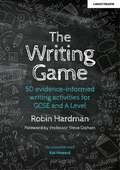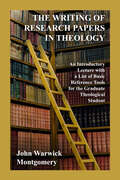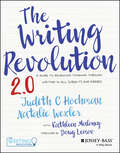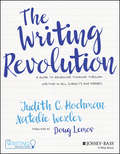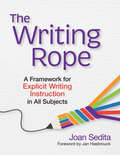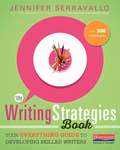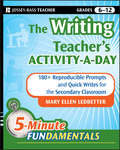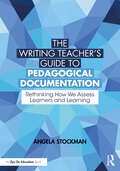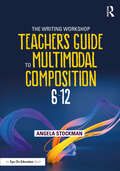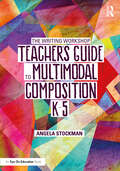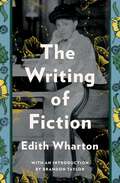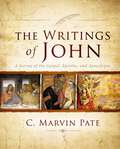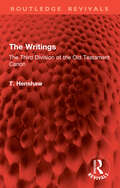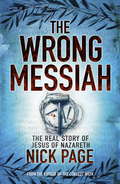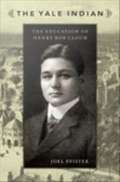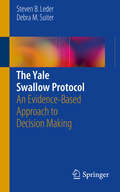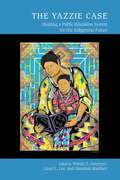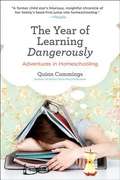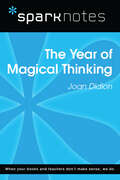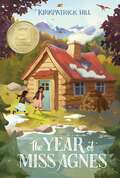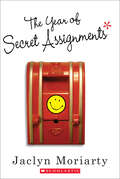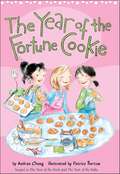- Table View
- List View
The Writing Game: 50 Evidence-Informed Writing Activities for GCSE and A Level
by Robin HardmanAs every humanities or social science teacher knows, success in exam years relies on pupils’ ability to blend subject knowledge with writing skills. But teachers face two significant problems in developing writing in their classroom: many pupils regard writing practice as a chore or a punishment; and research on writing instruction remains difficult for busy teachers to access. The Writing Game: 50 Evidence-Informed Writing Activities for GCSE and A Level aims to solve these problems by providing a must-read practical toolkit for teachers looking to help their pupils to write their way into the top grades, offering a menu of engaging lesson activities that can be modified to suit any subject context. With activities covering modelling, practice, and feedback, The Writing Game supports teachers to deliver research-informed strategies at every stage of the learning process. Perfect for teachers, middle leaders, and senior leaders, The Writing Game also contains tips on how to incorporate writing practice into regular subject content, formative assessment, and retrieval practice. Each activity is fully explained and accompanied by top tips for maximising effective learning, suggested adaptations, and links to appropriate research. Activities range from rapid five-minute starters and plenaries to whole-lesson extended writing tasks, with plenty in between, and busy teachers will be relieved to hear that many require very little preparation.
The Writing Of Research Papers In Theology: An Introductory Lecture with a List of Basic Reference Tools for the Graduate Student
by John Warwick MontgomeryA "how to" on theological research covering little known American and European resourses. Even though this was orignally written in 1957, this is a master class from before the age of the internet and still valuable today.
The Writing Revolution 2.0: A Guide to Advancing Thinking Through Writing in All Subjects and Grades
by Natalie Wexler Judith C. HochmanLead a writing revolution in your classroom with the proven Hochman Method Building on the success of the original best-seller, this new edition of The Writing Revolution adds valuable guidance for teachers seeking a way to bring their students' writing ability up to rigorous state standards. As thousands of educators have already discovered, The Writing Revolution provides the road map they need, clearly explaining how to incorporate the Hochman Method into their instruction, no matter what subject or grade they're teaching and regardless of the ability level of their students. The new edition provides a reorganized sequence of activities and even more student-facing examples, making it easier than ever to bring the method to your classroom. The Writing Revolution isn't a separate curriculum or program teachers need to juggle. Rather, it is a method providing strategies and activities that teachers can adapt to their preexisting curriculum and weave into their content instruction. By focusing on specific techniques that match their students' needs and providing them with targeted feedback, The Writing Revolution can turn weak writers into strong and confident communicators. In addition, the method can: Identify misconceptions and gaps in knowledge Boost reading comprehension and learning Improve organizational skills Enrich oral language Develop analytical abilities The Writing Revolution takes the mystery out of teaching students to write well.
The Writing Revolution: A Guide to Advancing Thinking Through Writing in All Subjects and Grades
by Natalie Wexler Judith C. Hochman"HELP! My Students Can't Write!" Why You Need a Writing Revolution in Your Classroom and How to Lead It. The Writing Revolution (TWR) provides a clear method of instruction that you can use no matter what subject or grade level you teach. The model, also known as The Hochman Method, has demonstrated, over and over, that it can turn weak writers into strong communicators by focusing on specific techniques that match their needs and by providing them with targeted feedback. Insurmountable as the challenges faced by many students may seem, TWR can make a dramatic difference. And the method does more than improve writing skills. It also helps: Boost reading comprehension Improve organizational and study skills Enhance speaking abilities Develop analytical capabilities TWR is as much a method of teaching content as it is a method of teaching writing. There's no separate writing block and no separate writing curriculum. Instead, teachers of all subjects adapt the TWR strategies and activities to their current curriculum and weave them into their content instruction. But perhaps what's most revolutionary about the TWR method is that it takes the mystery out of learning to write well. It breaks the writing process down into manageable chunks and then has students practice the chunks they need, repeatedly, while also learning content.
The Writing Rope: A Framework for Explicit Writing Instruction in All Subjects
by Jan Hasbrouck Joan SeditaWriting is a task as complex and multifaceted as reading—but it’s often taught as a single skill. Discover how to plan and deliver comprehensive, explicit, and evidence-based writing instruction with this groundbreaking book, aligned with IDA’s Structured Literacy approach and based on the latest research. <p><p> Joan Sedita's innovative Writing Rope weaves multiple skills and strategies into five fundamentals of a comprehensive writing curriculum: critical thinking, syntax (sentences), text structure, writing craft, and transcription (spelling and handwriting). Teachers of Grades 4-8 will get crystal-clear guidelines that demystify the process of helping students learn to write and write to learn across academic content areas. And with dozens of included templates, handouts, and other resources—available for download online—teachers will have all the tools they need to design and deliver explicit, high-quality writing instruction. <p><p> Perfect for professional development, this invaluable planning guide will help teachers apply the science of reading to the skill of writing—and help students master a critically important aspect of literacy.
The Writing Strategies Book: Your Everything Guide to Developing Skilled Writers
by Jennifer SerravalloStudents' needs to high-quality instruction is made simpler with 300 strategies.
The Writing Teacher's Lesson-a-Day: 180 Reproducible Prompts and Quick-Writes for the Secondary Classroom (JB-Ed: 5 Minute FUNdamentals #3)
by Mary Ellen LedbetterClassroom-tested methods for boosting secondary students' writing skills The Writing Teacher's Activity-a-Day offers teachers, homeschoolers, and parents 180 ready-to-use, reproducible activities that enhance writing skills in secondary students. Based on Ledbetter's extensive experience consulting to language arts teachers and school districts across the country, the classroom-tested activities included in this book teach students key literary and writing terms like allegory, elaboration, irony, personification, propaganda, voice, and more--and provide them with engaging examples that serve as models for their own Quick Writes. Contains writing prompts and sample passages in student-friendly language that connects abstract literary concepts to students' own lives Written by popular workshop presenter and veteran educator Mary Ellen Ledbetter Offers a user-friendly, value-packed resource for teaching writing skills Designed for English language arts teachers in grades 6-12, tutors, parents, learning specialists, homeschoolers, and consultants.
The Writing Teacher’s Guide to Pedagogical Documentation: Rethinking How We Assess Learners and Learning
by Angela StockmanThis book is a call to action for English and English Language Arts teachers who understand that data are not numbers alone, learning is impossible to quantify, and students are our very best teachers. Writing teacher Angela Stockman shows us how pedagogical documentation—the practice of making learning visible, capturing what is seen and heard, and then interpreting those findings in the company of our students and our colleagues—is a humbling and humane practice that grounds what we think we’ve come to know in the lived experiences of those we intend to serve. In this rich resource, she offers: processes and protocols for documenting learning and analyzing data; resources and planning tools to help you design and execute your own projects; and a digital documentation notebook that you can download for guidance, inspiration, and examples. With the powerful tools in this book, you’ll be inspired to reach students whose needs have been ignored by big data and whose identities have been erased by oppressive forms of assessment and evaluation.
The Writing Teacher’s Guide to Pedagogical Documentation: Rethinking How We Assess Learners and Learning
by Angela StockmanThis book is a call to action for English and English Language Arts teachers who understand that data are not numbers alone, learning is impossible to quantify, and students are our very best teachers.Writing teacher Angela Stockman shows us how pedagogical documentation—the practice of making learning visible, capturing what is seen and heard, and then interpreting those findings in the company of our students and our colleagues—is a humbling and humane practice that grounds what we think we’ve come to know in the lived experiences of those we intend to serve. In this rich resource, she offers: processes and protocols for documenting learning and analyzing data; resources and planning tools to help you design and execute your own projects; and a digital documentation notebook that you can download for guidance, inspiration, and examples With the powerful tools in this book, you’ll be inspired to reach students whose needs have been ignored by big data and whose identities have been erased by oppressive forms of assessment and evaluation.
The Writing Workshop Teacher's Guide to Multimodal Composition (6-12)
by Angela StockmanMultimodal composition is a meaningful and critical way for students to tell their stories, make good arguments, and share their expertise in today’s world. In this helpful resource, writer, teacher, and best-selling author Angela Stockman illustrates the importance of making writing a multimodal endeavor in 6-12 workshops by providing peeks into the classrooms she teaches within. Chapters address what multimodal composition is, how to situate it in a writing workshop that is responsive to the unique needs of writers, how to handle curriculum design and assessment, and how to plan instruction. The appendices offer tangible tools and resources that will help you implement and sustain this work in your own classroom. Ideal for teachers of grades 6-12, literacy coaches, and curriculum leaders, this book will help you and your students reimagine what a workshop can be when the writers within it produce far more than written words.
The Writing Workshop Teacher’s Guide to Multimodal Composition (K-5)
by Angela StockmanMultimodal composition is a meaningful and critical way for students to tell their stories, make good arguments, and share their expertise in today’s world. In this helpful resource, writer, teacher, and best-selling author Angela Stockman illustrates the importance of making writing a multimodal endeavor in K-5 workshops by providing peeks into the classrooms she teaches within. Chapters address what multimodal composition is, how to situate it in a writing workshop that is responsive to the unique needs of writers, how to handle curriculum design and assessment, and how to plan instruction. The appendices offer tangible tools and resources that will help you implement and sustain this work in your own classroom. Ideal for teachers of grades K-5, literacy coaches, and curriculum leaders, this book will help you and your students reimagine what a workshop can be when the writers within it produce far more than written words.
The Writing of Fiction: The Classic Guide To The Art Of The Short Story And The Novel (The\collected Works Of Edith Wharton)
by Edith WhartonA rare work of nonfiction from Edith Wharton, The Writing of Fiction contains brilliant advice on writing from the first woman ever to win a Pulitzer Prize -- for her first novel The Age of Innocence. In The Writing of Fiction, Wharton provides general comments on the roots of modern fiction, the various approaches to writing a piece of fiction, and the development of form and style. She also devotes entire chapters to the telling of a short story, the construction of a novel, and the importance of character and situation in the novel. Not only a valuable treatise on the art of writing, The Writing of Fiction also allows readers to experience the inimitable but seldom heard voice of one of America's most important and beloved writers, and includes a final chapter on the pros and cons of Marcel Proust.
The Writings of John: A Survey of the Gospel, Epistles, and Apocalypse
by C. Marvin PateThe writings of John are some of the most foundational New Testament documents for today’s Christians. Most evangelical teaching about the life of Jesus begins with the Gospel of John, and Christian teaching on the end times relies heavily on the book of Revelation. Students, pastors, and lay learners need solid, up-to-date resources like this book to responsibly study and understand John’s writings. C. Marvin Pate addresses John’s writings according to their logical divisions: the Gospel of John, the Johannine Epistles, and Revelation. Each section includes a thorough introduction to relevant interpretive issues, including historical background, cultural setting, and theological context. Pate presents a two-fold historical setting for John’s gospel, encouraging readers to consider the text from the perspective of Jesus’ day and from John’s situation in Asia Minor sixty years later. He examines the Johannine epistles on issues like authorship, audience, and theological perspective. For the Apocalypse, Pate explores the challenges of John’s first readers, the nature of apocalyptic literature, and the Roman imperial cult, including as well an explanation of how the church has interpreted Revelation over the years. With its thorough discussion, textbook design and four-color interior, The Writings of John sets the standard for introductory texts on biblical books or collections.
The Writings: The Third Division of the Old Testament Canon (Routledge Revivals)
by T. HenshawOriginally published in 1963, this work is a study of the Old Testament books known as ‘The Writings’ (Ketuvim). Introductory chapters supply the necessary background material and are followed by separate chapters on the books themselves, their origin, purpose, contents date of composition, permanent influence and literary merit. The book is lucidly written and in a field in which scholars differ widely as to facts and interpretation, the author has succeeded in giving a wide range of views. The historical chapters describing the background to the literature are accurate and readable
The Wrong Messiah: The Real Story of Jesus of Nazareth
by Nick PageHe came from the wrong social class, the wrong place and the wrong profession. He ate with the wrong people, championed the wrong causes and attracted the wrong kind of supporters. He even spoke with the wrong accent. In fact everything about Jesus of Nazareth was wrong. How could this odd-job man be God’s Messiah? In this illuminating new biography, Nick Page strips away centuries of misrepresentation and myth to reveal the real personality portrayed in the gospels. Drawing on a wealth of historical and archaeological research, the result is a startling and vivid new portrait of Yeshua ben Yosef. THE WRONG MESSIAH will change the way you view Jesus: the man who in so many ways seemed utterly wrong, but who history has proved triumphantly to be right.
The Yale Indian: The Education of Henry Roe Cloud
by Joel PfisterHonored in his own time as one of the most prominent Indian public intellectuals, Henry Roe Cloud (c. 1884-1950) fought to open higher education to Indians. Joel Pfister's extensive archival research establishes the historical significance of key chapters in the Winnebago's remarkable life. Roe Cloud was the first Indian to receive undergraduate and graduate degrees from Yale University, where he was elected to the prestigious and intellectual Elihu Club. Pfister compares Roe Cloud's experience to that of other "college Indians" and also to African Americans such as W. E. B. Du Bois. Roe Cloud helped launch the Society of American Indians, graduated from Auburn seminary, founded a preparatory school for Indians, and served as the first Indian superintendent of the Haskell Institute (forerunner of Haskell Indian Nations University). He also worked under John Collier at the Bureau of Indian Affairs, where he was a catalyst for the Indian New Deal. Roe Cloud's white-collar activism was entwined with the Progressive Era formation of an Indian professional and managerial class, a Native "talented tenth," whose members strategically used their contingent entry into arenas of white social, intellectual, and political power on behalf of Indians without such access. His Yale training provided a cross-cultural education in class-structured emotions and individuality. While at Yale, Roe Cloud was informally adopted by a white missionary couple. Through them he was schooled in upper-middle-class sentimentality and incentives. He also learned how interracial romance could jeopardize Indian acceptance into their class. Roe Cloud expanded the range of what modern Indians could aspire to and achieve.
The Yale Swallow Protocol
by Steven B. Leder Debra M. SuiterThe Yale Swallow Protocol is an evidence-based protocol that is the only screening instrument that both identifies aspiration risk and, when passed, is able to recommend specific oral diets without the need for further instrumental dysphagia testing. Based upon research by Drs. Steven B. Leder and Debra M. Suiter, an easily administered, reliable and validated swallow screening protocol was developed and can be used by speech-language pathologists, nurses, otolaryngologists, oncologists, neurologists, intensivists and physicians assistants. In addition, the protocol can be used in a variety of environments, including acute care, rehabilitation and nursing homes. The Yale Swallow Protocol meets all of the criteria necessary for a successful screening test, including being simple to administer, cross-disciplinary, cost effective, acceptable to patients and able to identify the target attribute by giving a positive finding when aspiration risk is present and a negative finding when aspiration risk is absent. Additionally, early and accurate identification of aspiration risk can significantly reduce health-care costs associated with recognized prandial aspiration.
The Yazzie Case: Building a Public Education System for Our Indigenous Future (Studies in Indigenous Community Building)
by Wendy S. Greyeyes, Lloyd L. Lee, and Glenabah MartinezThe story of Wilhelmina Yazzie and her son’s effort to seek an adequate education in New Mexico schools revealed an educational system with poor policy implementation, inadequate funding, and piecemeal educational reform. The 2018 decision in the Yazzie/Martinez lawsuit proved what has always been known: the educational needs of Native American students were not being met.In this superb collection of essays, the contributors cover the background and significance of the lawsuit and its impact on racial and social politics. The Yazzie Case provides essential reading for educators, policy analysts, attorneys, professors, and students to understand the historically entrenched racism and colonial barriers impacting all Native American students in New Mexico’s public schools. It constructs a new vision and calls for transformational change to resolve the systemic challenges plaguing Native American students in New Mexico’s public education system.ContributorsGeorgina BadoniCynthia BenallyRebecca Blum MartínezNathaniel CharleyMelvatha R. CheeShiv DesaiDonna DeyhleTerri FlowerdayWendy S. GreyeyesAlex KinsellaLloyd L. LeeTiffany S. LeeNancy LópezHondo Louis (photographer)Glenabah MartinezNatalie MartinezJonathan NezCarlotta Penny BirdPreston SanchezKaren C. Sanchez-GriegoChristine SimsLeola Tsinnajinnie PaquinVincent WeritoWilhelmina Yazzie
The Year of Learning Dangerously
by Quinn CummingsA year of homeschooling. What could possibly go wrong? In this honest and wry memoir, popular blogger, author, and former child actor Quinn Cummings recounts her family's decision to wade into the unfamiliar waters of homeschooling - the fastest-growing educational trend of our time -- despite a chronic lack of discipline, some major gaps in academic knowledge, and a serious case of math aversion. (And that's just Quinn.) Quinn's fearless quest includes some self-homeschooling - reading up on education reform, debating the need for "socialization," and infiltrating conferences filled with Radical Unschoolers as well as Christian fundamentalists (and even chaperoning a homeschool prom). Part personal narrative, part social commentary, and part how-not-to guide, The Year of Learning Dangerously will make you laugh and make you think. And there may or may not be a quiz at the end. OK, there's no quiz. Probably. ing Dangerously will make you laugh and make you think. And it may or may not have a quiz at the end. OK, there isn't a quiz. Probably.
The Year of Learning Dangerously: Adventures in Homeschooling
by Quinn CummingsThink homeschooling is only for a handful of eccentrics on either end of the political spectrum? Think again. Today in America, two million primary- and secondary-school students are homeschooled. Growing at a rate of 10 percent annually, homeschooling represents the most dramatic change in American education since the invention of the mimeograph-and the story has only just begun. In The Year of Learning Dangerously, popular blogger, author, and former child actor Quinn Cummings recounts her family’s decision to wade into the unfamiliar waters of homeschooling-despite a chronic lack of discipline, some major gaps in academic knowledge, and a serious case of math aversion. (That description refers to Quinn. ) Trying out the latest trends, attending key conferences (incognito, of course), and recounting the highlights and lowlights along the way, Quinn takes her daughter’s education into her own hands, for better and for worse. Part memoir, part social commentary, and part how-not-to guide, The Year of Learning Dangerously will make you laugh and make you think. And it may or may not have a quiz at the end. OK, there isn’t a quiz. Probably. .
The Year of Magical Thinking (SparkNotes Literature Guide Series)
by SparkNotesThe Year of Magical Thinking (SparkNotes Literature Guide) by Joan Didion Making the reading experience fun! Created by Harvard students for students everywhere, SparkNotes is a new breed of study guide: smarter, better, faster. Geared to what today's students need to know, SparkNotes provides: *Chapter-by-chapter analysis *Explanations of key themes, motifs, and symbols *A review quiz and essay topicsLively and accessible, these guides are perfect for late-night studying and writing papers
The Year of Miss Agnes
by Kirkpatrick HillA year they'll never forgetTen-year-old Frederika (Fred for short) doesn't have much faith that the new teacher in town will last very long. After all, they never do. Most teachers who come to their one-room schoolhouse in remote, Alaska leave at the first smell of fish, claiming that life there is just too hard.But Miss Agnes is different -- she doesn't get frustrated with her students, and she throws away old textbooks and reads Robin Hood instead! For the first time, Fred and her classmates begin to enjoy their lessons and learn to read and write -- but will Miss Agnes be like all the rest and leave as quickly as she came?
The Year of Secret Assignments
by Jaclyn MoriartyIn this epistolary novel, three Aussie private school girls enter a pen pal program that leads to friendship, love, mischief, mystery, and revenge.The Ashbury-Brookfield pen pal program is designed to bring together the two rival schools in a spirit of harmony and “the Joy of the Envelope.” But when Cassie, Lydia, and Emily send their first letters to Matthew, Charlie, and Sebastian, things don’t go quite as planned. What starts out as a simple letter exchange soon leads to secret missions, false alarms, lock picking, mistaken identities, and an all-out war between the schools—not to mention some really excellent kissing.Praise for The Year of Secret Assignments“Who can resist Moriarty’s biting humor?” —Kirkus Reviews“This energetic novel reveals the author’s keen understanding of teen dynamics and invites audience members to read between the lines to discover what makes each character tick. Containing elements of mystery, espionage, romance and revenge, Moriarty’s story will likely satisfy hearty appetites for suspense and fun.” —Publishers Weekly
The Year of the Fortune Cookie (The Anna Wang Novels #3)
by Andrea ChengEleven-year-old Anna heads off to sixth grade, leaving the comfort and familiarity of elementary school behind and entering the larger, more complex world of middle school. Surrounded by classmates who have their roots all in America, Anna begins to feel out of place and wonders where she really belongs. When Anna takes a trip to China, she not only explores a new country and culture, but finds answers to her questions about whether she is more Chinese or more American. This young illustrated chapter book is the third in the series that includes The Year of the Book and The Year of the Baby. For grades 1-4.
The Yellow Bus
by Loren LongPerfect for fans of Love and Hello, Lighthouse, The Yellow Bus from #1 New York Times bestselling Loren Long is a tender and hopeful new classic about a forgotten school bus that finds happiness and purpose in the most unexpected places--and in the journey along the way. <P><P> There is a bright yellow bus who spends her days driving. She loves carrying children from one important place to another. Every morning they climb in... Pitter-patter, pitter-patter, giggle, giggle-patter. And they fill her with joy. <P><P> As time passes, things change. The Yellow Bus gets a new driver, a new route, and new passengers, young and old. Until one day the driving stops for good, and the Yellow Bus is left on her own. And yet, no matter where she is, the Yellow Bus still finds joy and discovery in the world around her. <P><P> With stirring black-and-white artwork and powerful pops of color, The Yellow Bus is a poignant reflection on the many new beginnings life has to offer. <P><P><i>Advisory: Bookshare has learned that this book offers only partial accessibility. We have kept it in the collection because it is useful for some of our members. Benetech is actively working on projects to improve accessibility issues such as these.</i> <p> <b>New York Times Bestseller</b>
